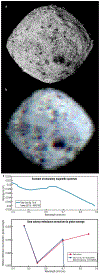The unexpected surface of asteroid (101955) Bennu
- PMID: 30890786
- PMCID: PMC6557581
- DOI: 10.1038/s41586-019-1033-6
The unexpected surface of asteroid (101955) Bennu
Abstract
NASA'S Origins, Spectral Interpretation, Resource Identification and Security-Regolith Explorer (OSIRIS-REx) spacecraft recently arrived at the near-Earth asteroid (101955) Bennu, a primitive body that represents the objects that may have brought prebiotic molecules and volatiles such as water to Earth1. Bennu is a low-albedo B-type asteroid2 that has been linked to organic-rich hydrated carbonaceous chondrites3. Such meteorites are altered by ejection from their parent body and contaminated by atmospheric entry and terrestrial microbes. Therefore, the primary mission objective is to return a sample of Bennu to Earth that is pristine-that is, not affected by these processes4. The OSIRIS-REx spacecraft carries a sophisticated suite of instruments to characterize Bennu's global properties, support the selection of a sampling site and document that site at a sub-centimetre scale5-11. Here we consider early OSIRIS-REx observations of Bennu to understand how the asteroid's properties compare to pre-encounter expectations and to assess the prospects for sample return. The bulk composition of Bennu appears to be hydrated and volatile-rich, as expected. However, in contrast to pre-encounter modelling of Bennu's thermal inertia12 and radar polarization ratios13-which indicated a generally smooth surface covered by centimetre-scale particles-resolved imaging reveals an unexpected surficial diversity. The albedo, texture, particle size and roughness are beyond the spacecraft design specifications. On the basis of our pre-encounter knowledge, we developed a sampling strategy to target 50-metre-diameter patches of loose regolith with grain sizes smaller than two centimetres4. We observe only a small number of apparently hazard-free regions, of the order of 5 to 20 metres in extent, the sampling of which poses a substantial challenge to mission success.
Figures







References
-
- Lauretta DS et al. The OSIRIS‐REx target asteroid (101955) Bennu: Constraints on its physical, geological, and dynamical nature from astronomical observations. Meteoritics Planet. Sci 50, 834–849 (2015).
-
- Hergenrother CW et al. Lightcurve, color and phase function photometry of the OSIRIS-REx target asteroid (101955) Bennu. Icarus 226, 663–670 (2013).
-
- Clark BE et al. Asteroid (101955) 1999 RQ36: Spectroscopy from 0.4 to 2.4 μm and meteorite analogs. Icarus 216, 462–475 (2011).
-
- Lauretta DS et al. OSIRIS-REx: Sample return from asteroid (101955) Bennu. Space Sci. Rev 212, 925–984 (2017).
-
- Emery JP, Fernández YR, Kelley MSP, Warden KT, Hergenrother C, Lauretta DS, Drake MJ, Campins H, and Ziffer J. “Thermal infrared observations and thermophysical characterization of OSIRIS-REx target asteroid (101955) Bennu.” Icarus 234, 17–35 (2014).
MeSH terms
Grants and funding
LinkOut - more resources
Full Text Sources

